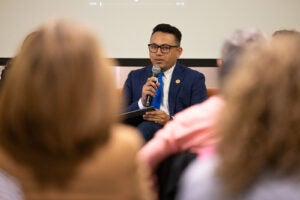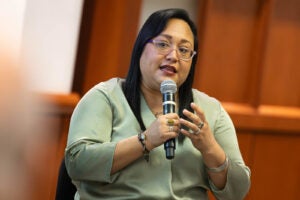Talking about journalism in Nicaragua means talking about resistance, courage—and exile. For nearly 10 years, Nicaraguan journalists have endured repression under President Daniel Ortega’s administration. The situation is now one of the most concerning in the region, which is why it was a focus during the 18th Ibero-American Colloquium on Digital Journalism on March 29.
Moderated by Carlos Lauría, executive director of the Inter American Press Association (IAPA), the panel “Nicaragua: Journalism in Exile” centered on escalating threats and the strategies Nicaraguan journalists have adopted to continue their work from abroad.
Lauría opened the conversation by citing data from the Fundación por la Libertad de Expresión y Democracia (FLED), which reported at least 289 journalists in exile, more than 50 news outlets shut down or taken over by the government, as well as journalists imprisoned and/ or forcibly disappeared. He also pointed to new forms of censorship, including the government’s recent blocking of websites with the .ni domain.
“Most of the Nicaraguan press is now based in Costa Rica,” Lauría said, before inviting panelists to discuss how they continue reporting while outside the country.
“We’ve had to work with a newsroom scattered across several countries,” said Nayel Martínez, editor at the newspaper La Prensa. La Prensa has been one of the outlets most heavily targeted by the regime of Copresidents Daniel Ortega and Rosario Murillo.
For years, the outlet faced daily obstacles: blocked access to newsprint, harassment from the national tax agency, and restrictions on reporting. But it was the confiscation of La Prensa’s headquarters and the forced exile of chief editor Juan Lorenzo Holmann that led the newsroom to relocate abroad.

Gerall Chaves, founder of Nicaragua Actual, speaks at a panel on censorship and exile at the 18th Ibero-American Colloquium on Digital Journalism. (Patricia Lim/KUT News)
According to Martínez, the newspaper now operates with journalists based in countries including Costa Rica, Spain, Canada, Mexico and the United States. Time zone differences and the need for journalists to hold second jobs in their host countries make the work even more difficult.
“We were forced to leave our country,” Martinez said. “We did not want to leave, but unfortunately we were pushed out.”
On a personal level, she always recommends therapy. “It’s the only way to overcome this—leaving your life, your family, your country,” she said.
The exile of journalists has also led to the creation of new media outlets that cover not only events in Nicaragua but also issues important to the Nicaraguan diaspora. One such outlet is Nicaragua Actual, founded by Gerall Chaves, which recently surpassed 100,000 subscribers on YouTube.
“This is a victory for the audience,” Chaves told attendees at the Colloquium, where he encouraged them to watch a documentary on what it means to do journalism in exile. The 21-minute film shows the daily challenges journalists face—from turning their homes into newsrooms and finding money to survive, to developing strategies to protect their lives.
“I laugh because I think I’ve moved past the stage of thinking about Nicaragua every single day,” Chaves said. “I think support networks have helped me stay here, keep reporting, challenge the regime, and show up in front of a camera every day to tell people what’s happening in Nicaragua.”
Independent journalist and contributor to the human rights organization Nicaragua Nunca Más, Arquímedes González, said journalists not only face obstacles in doing their work, but even in trying to leave the country legally. In his case, his passport was confiscated—leaving him without an official travel document.
González explained that many Nicaraguans face the same problem, essentially becoming stateless.
“This is a legal and judicial limitation that also affects your professional development, because you do not have documents and there is no clear way forward,” González said. “It is a major challenge.”
González called on host countries to recognize the situation, noting that more than 20 stateless journalists are currently in exile.
The organization Independent Journalists and Communicators of Nicaragua, or PCIN for its initials in Spanish, is among those that have most closely tracked the exile of journalists. Cofounder Wendy Quintero Chávez and board president Julio López, who heads the the outlet Onda Local, were present at the Colloquium.
Onda Local, now 25 years old, began as a traditional radio station but “because of censorship” was forced to become a digital outlet, López said. He added that due to the recent government blocking of the .ni domain, the outlet had to change its web address.
“In the face of a dictatorship, you also have to anticipate—and I think that is one of the lessons Nicaraguan journalism must leave behind: anticipate,” López said.
He explained the persecution of journalists didn’t begin when authorities repressed political protests in 2018, but when the Ortega administration came to power and began “reconfiguring Nicaraguan media through the acquisition and consolidation of media.”
This control is especially noticeable with radio stations. According to López, most FM stations are music-focused, while AM stations are controlled by pro-government or religious groups. These avoid news and political coverage altogether.
“They have not even said a word about the religious persecution taking place in Nicaragua,” López said. “That is to say, they are under total censorship.”
PCIN has documented more than 60 media outlets shut down, including the confiscation of major outlets like La Prensa, 100% Noticias and Confidencial.
“With this, the government narrative is the one that wins out,” López said. “We see how silence is imposed on traditional media, and how it affects people’s right to access the media and express themselves freely.”

Wendy Quintero Chávez, cofounder of Independent Journalists and Communicators of Nicaragua, speaks at a panel on censorship and exile at the 18th Ibero-American Colloquium on Digital Journalism. (Patricia Lim/KUT News)
Wendy Quintero of PCIN said journalists in Nicaragua continue to flee into exile. Just a week before the Colloquium, three more journalists left the country, she said. This exodus includes all types of media workers—from photojournalists to administrative staff and even drivers who transported reporters.
But Quintero also spoke about the broader violation of rights facing the Nicaraguan population. “In Costa Rica alone, there are more than 200,000 people seeking asylum,” ,” she said. “These are Nicaraguans who, in most cases, simply attended protests—as is their right, to express themselves freely and share their opinions.”
Quintero highlighted the case of four journalists currently subjected to “forced disappearance” and “criminalization.” While three of them are known to be in prison, their families and lawyers are not allowed to see them. The case of Fabiola Tercero is especially alarming to organizations like PCIN, as the last anyone heard of her was when police raided her home. Her whereabouts remain unknown.
“We are also here for them, to remind the world of what is happening in Nicaragua,” Quintero said. “Do not leave us alone. There are many ways to support us—not necessarily with money. You can engage with what we are doing, with the content we are producing on our platforms. Today more than ever, Nicaragua is an example of journalistic resistance—and we will keep going.”
Before the panel on Nicaragua, Lauría spoke about the Latin American Network of Journalism in Exile, or Relpex for its initials in Spanish. The initiative, led by the Inter American Press Association (IAPA), began operating last November in response to the growing crisis of exile and the forced displacement of journalists.
He said the issue of exile affects not only countries like Nicaragua, Cuba and Venezuela, but also increasingly includes Guatemala, Ecuador and El Salvador.
“Our idea at IAPA was to figure out how we can help journalists and media outlets working from exile to continue doing their jobs,” Lauría said.
With initial funding from the National Endowment for Democracy (NED), the network began seeking allies to avoid duplicating efforts. In its first few months, Relpex has provided emergency assistance, such as plane tickets and legal representation.

Carlos Lauría, executive director of the Inter American Press Association (IAPA). (Photo: Patricia Lim/ Knight Center)
Another program of the network involves a commitment to support media outlets that employ at least 10 exiled journalists by supplementing their salaries. “That way, journalists do not have to find other sources of income and can focus calmly and fully on journalism,” Lauría said.
He also spoke about the launch of the platform PeriodismoLibre.org on April 7. A project of the DW Akademie in collaboration with UNESCO, the Press and Freedom of Expression Institute (IPLEX) and Relpex, the platform provides resources, information and initiatives available to journalists in exile across the region.
Relpex has more than 184 members, helping document a phenomenon that is otherwise very difficult to track, Lauría said. Of the members, 47 percent are women and 53 percent are men. Twenty-seven percent are no longer working as journalists, and that number increases for those exiled in North American countries. The main host countries are Costa Rica, the United States and Spain. Changes in U.S. immigration policy have added even more uncertainty for exiled journalists.
One of the key findings is that the primary need among these journalists is to find jobs and projects. “To reconnect with the profession,” Lauría said.
Another area the network hopes to address, based on its findings, is the need for psychosocial support.
“Many of them, overwhelmed by the experience, do not always realize they need this kind of help—but there is no doubt they do,” Lauría said. “Because to return to work, to keep working, they need to build resilience to get through that adversity and come out stronger.”